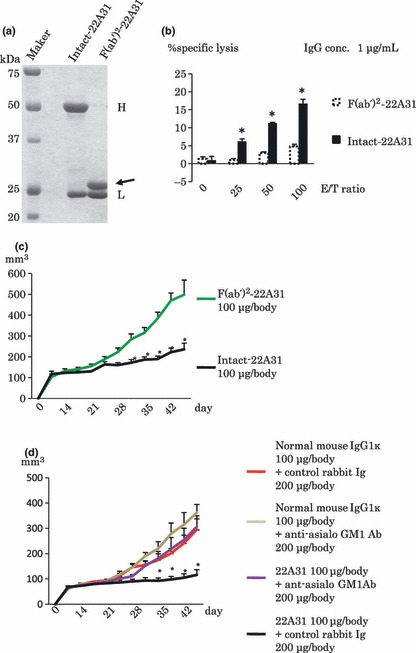Figure 4.

Contribution of the Fc portion and natural killer (NK) cells to the antitumor effect of 22A31 in vivo. (a) Preparation of 22A31 F(ab′)2 fragment. Ten μg of intact‐22A31 or F(ab′)2‐22A31 were electrophoresed using SDS‐PAGE and visualized Coomassie Brilliant Blue (CBB)‐staining. Arrow indicates heavy chain of F(ab′)22‐22A31. H and L indicate heavy chain of intact‐22A31 and light chain of both antibodies. (b) Intact‐ or F(ab′)2‐22A31‐inducd ADCC against ACC‐MESO‐4 tumor cells with purified NK cells. ADCC induced by 1 μg/mL of Intact‐ or F(ab′)2‐22A31 was examined at indicated effector/target ratios when purified NK cells were used as effector cells. (c) Antitumor effect of intact‐ or F(ab′)2‐22A31 against ACC‐MESO‐4. One hundred μg/body of Intact‐22A31 or F(ab′)2‐22A31 was intratumorally injected twice per week. Mice were treated 10 times with the respective antibody. Median tumor volume and SD of xenografts are indicated (n = 5). (d) Antitumor effect of 22A31 in NK cell‐depleted mice. ACC‐MESO‐4 tumor‐bearing mice were treated with 200 μg/body of anti‐asialo GM1 Ab to deplete NK cells or control rabbit Ig, then intratumorally injected with 100 μg/body of intact‐22A31 or control Ig twice per week as described in the Materials and Methods. Median tumor volume and SD of xenografts are indicated (n = 5). Asterisk indicates statistical significance.
